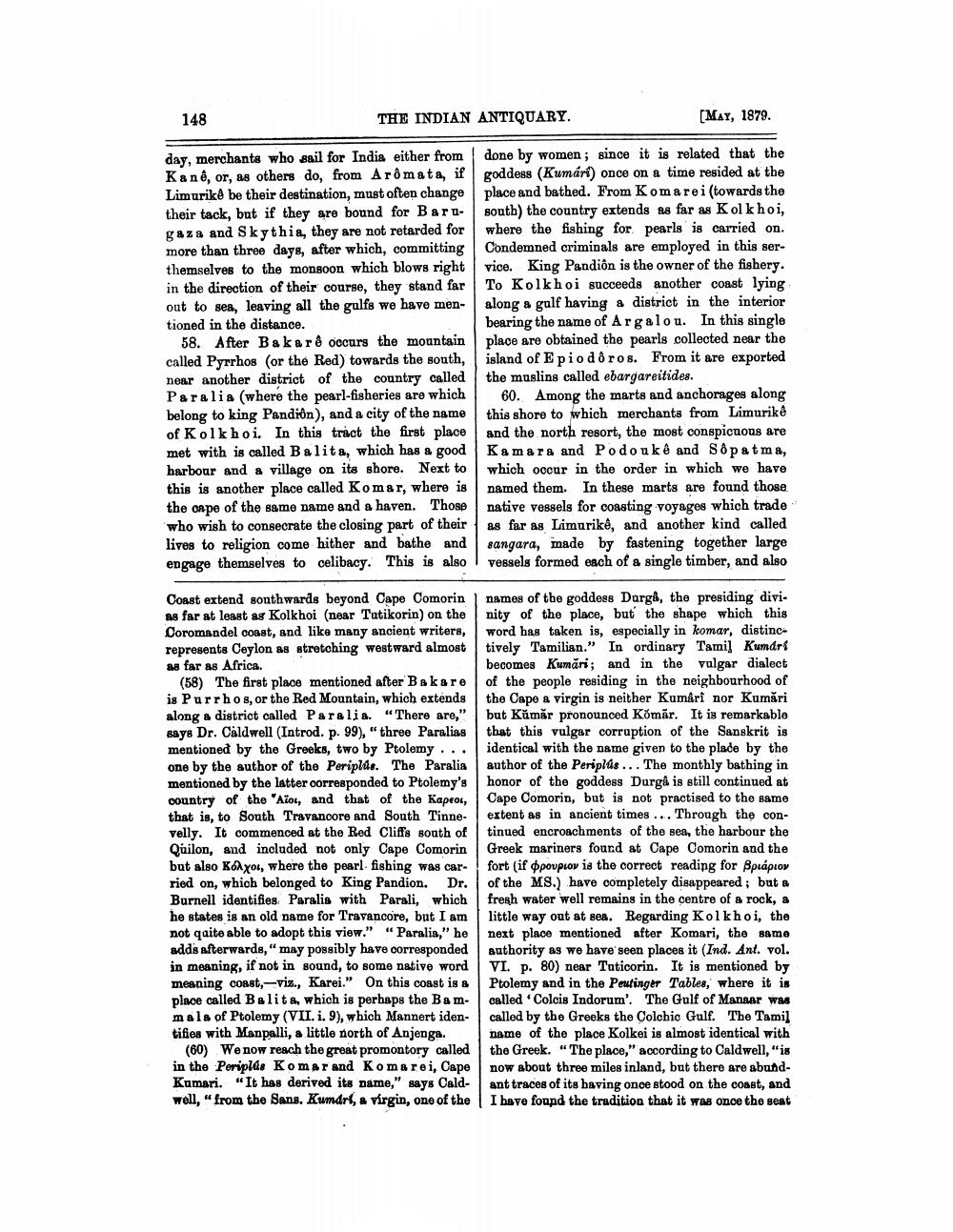________________
148
THE INDIAN ANTIQUARY.
[May, 1879.
day, merchants who sail for India either from Kanê, or, as others do, from Arômata, if Limurikê be their destination, must often change their tack, but if they are bound for Barugaza and Skythia, they are not retarded for more than three days, after which, committing themselves to the monsoon which blows right in the direction of their course, they stand far out to sea, leaving all the gulfs we have mentioned in the distance.
58. After Bakare occurs the mountain called Pyrrhos (or the Red) towards the south, near another district of the country called Paralia (where the pearl-fisheries are which belong to king Pandion), and a city of the name of Kolkhoi. In this tract the first place met with is called Balita, which has a good harbour and a village on its shore. Next to this is another place called Komar, where is the oape of the same name and a haven. Those who wish to consecrate the closing part of their lives to religion come hither and bathe and engage themselves to celibacy. This is also
done by women; since it is related that the goddess (Kumári) once on a time resided at the place and bathed. From Komarei (towards the south) the country extends as far as Kolkhoi, where the fishing for pearls is carried on. Condemned criminals are employed in this service. King Pandion is the owner of the fishery. To Kolkhoi succeeds another coast lying along a galf having a district in the interior bearing the name of Argalou. In this single place are obtained the pearls collected near the island of Epio dôros. From it are exported the muslins called ebargareitides.
60. Among the marts and anchorages along this shore to which merchants from Limurikê and the north resort, the most conspicuous are Kamara and Podou kê and Sopatma, which occur in the order in which we have named them. In these marts are found those native vessels for coasting voyages which trade as far as Limurike, and another kind called sangara, inade by fastening together large vessels formed each of a single timber, and also
Coast extend sonthwards beyond Cape Comorin as far at least as Kolkhoi (near Tatikorin) on the Coromandel coast, and like many ancient writers, represents Ceylon as stretching westward almost 28 far as Africa.
(58) The first place mentioned after Bakare is Purrhos, or the Red Mountain, which extends along a district called Paralia. "There are," says Dr. Caldwell (Introd. p. 99)," three Paralias mentioned by the Greeks, two by Ptolemy... one by the author of the Peripide. The Paralia mentioned by the latter corresponded to Ptolemy's country of the 'Aiot, and that of the Kaprot, that is, to South Travancore and South Tinnevelly. It commenced at the Red Cliffs south of Quilon, and included not only Cape Comorin but also Koyou, where the pearl fishing was car- ried on, which belonged to King Pandion. Dr. Burnell identifies. Paralis with Parali, which he states is an old name for Travancore, but I am not quite able to adopt this view." "Paralia," he adds afterwards," may possibly have corresponded in meaning, if not in sound, to some native word meaning coast,-viz., Karei." On this coast is a place called Balita, which is perhaps the Bammals of Ptolemy (VII. i. 9), which Mannert identifies with Manpalli, a little north of Anjenga.
(60) We now reach the great promontory called in the Periplds Komar and Komarei, Cape Kumari. "It has derived its name," says Cald- Well," from the Sans. Kumdrt, a virgin, one of the
names of the goddess Darga, the presiding divi. nity of the place, but the shape which this word has taken is, especially in komar, distinctively Tamilian." In ordinary Tamil Kumar becomes Kumări; and in the vulgar dialect of the people residing in the neighbourhood of the Cape a virgin is neither Kumâri nor Kumări but Kūmăr pronounced Komár. It is remarkable that this vulgar corruption of the Sanskrit is identical with the name given to the plade by the author of the Periplus ... The monthly bathing in honor of the goddess Durgå is still continued at Cape Comorin, but is not practised to the same extent as in ancient times ... Through the continued encroachments of the sea, the harbour the Greek mariners found at Cape Comorin and the fort (if ppovprov is the correct reading for Bpıáploy of the MS.) have completely disappeared; but a fresh water well remains in the centre of a rock, a little way out at sea. Regarding Kolkhoi, the next place mentioned after Komari, the same authority as we have seen places it (Ind. Ant. vol. VI. p. 80) near Tuticorin. It is mentioned by Ptolemy and in the Peutinger Tables, where it is called 'Colcis Indorum'. The Gulf of Manaar was called by the Greeks the Colchic Gulf. The Tamil name of the place Kolkei is almost identical with the Greek. "The place, according to Caldwell, "is now about three miles inland, but there are abundant traces of its having once stood on the coast, and I have found the tradition that it was once the seat




